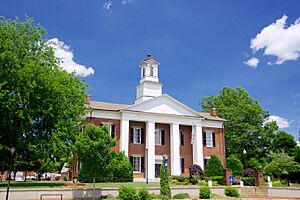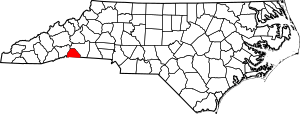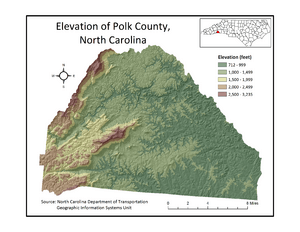Polk County, North Carolina facts for kids
Quick facts for kids
Polk County
|
|||
|---|---|---|---|

Polk County Courthouse
|
|||
|
|||

Location within the U.S. state of North Carolina
|
|||
 North Carolina's location within the U.S. |
|||
| Country | |||
| State | |||
| Founded | 1855 | ||
| Named for | Colonel William Polk | ||
| Seat | Columbus | ||
| Largest municipality | Tryon | ||
| Area | |||
| • Total | 238.45 sq mi (617.6 km2) | ||
| • Land | 237.69 sq mi (615.6 km2) | ||
| • Water | 0.76 sq mi (2.0 km2) 0.32% | ||
| Population
(2020)
|
|||
| • Total | 19,328 | ||
| • Estimate
(2023)
|
20,060 |
||
| • Density | 81.057/sq mi (31.2962/km2) | ||
| Time zone | UTC−5 (Eastern) | ||
| • Summer (DST) | UTC−4 (EDT) | ||
| Congressional district | 11th | ||
Polk County is a place in the state of North Carolina, USA. It's called a county, which is like a smaller area within a state. In 2020, about 19,328 people lived there. The main town, where the county government is, is called Columbus.
Contents
History of Polk County
Polk County was created in 1855. It was formed from parts of two other counties: Henderson and Rutherford. The county was named after William Polk. He was a colonel who fought in the American Revolutionary War.
A big event happened here in 2018. The Tryon International Equestrian Center hosted the 2018 FEI World Equestrian Games. This is a huge competition for horse riders from all over the world. It took place near the town of Mill Spring.
Geography and Nature in Polk County
Polk County covers about 238.45 square miles (617.6 square kilometers). Most of this area is land, about 237.69 square miles (615.6 square kilometers). A small part, 0.76 square miles (1.97 square kilometers), is water. This makes it the fifth-smallest county in North Carolina by total area.
The biggest lake in the county is Lake Adger. It's about 5 miles (8 kilometers) north of Columbus. Lake Adger is a reservoir, which is a large artificial lake used to store water. It was made by building a dam on the Green River. The Green River flows from west to east across the county.
The land in Polk County changes a lot in height. It ranges from less than 800 feet (244 meters) near where the Green River meets the Broad River. It goes up to over 3,200 feet (975 meters) on Tryon Peak and Wildcat Spur. These are the highest points in the county.
Polk County is in a special area where two different land types meet. The western part of the county is in the Blue Ridge Mountains. The eastern two-thirds is in the Piedmont region. Because it's between these two areas, Polk County is often called part of the foothills.
Protected Natural Areas
Polk County has several places that are protected to keep nature safe. These include:
- Anne Elizabeth Suratt Nature Center
- Bradley Nature Preserve at Alexander's Ford (part)
- Chimney Rock State Park (part)
- Green River Game Lands (part)
- Pearson's Falls
- Shunkawauken Falls
Major Water Bodies
Here are some of the important rivers and creeks in Polk County:
- Broad River
- Colt Creek
- Cove Creek
- Green River
- North Pacolet River
- Hughes Creek
- Lake Adger
- Little White Oak Creek
- Ostin Creek
- Vaughns Creek
- Walnut Creek
- White Oak Creek
Counties Nearby
Polk County shares its borders with these other counties:
- Rutherford County – to the northeast
- Spartanburg County, South Carolina – to the south-southeast
- Greenville County, South Carolina – to the south-southwest
- Henderson County – to the west
Main Roads and Highways
Several important roads pass through Polk County:
 I-26
I-26 US 74
US 74 US 176
US 176 NC 9
NC 9 NC 108
NC 108
Interstate 26 (I-26) and U.S. Highway 74 (US 74) meet in Columbus. I-26 helps people travel to bigger cities like Asheville and Spartanburg, South Carolina.
U.S. Highway 176 (US 176) also goes through Polk County. Before I-26 was finished in 1976, US 176 was the main road connecting towns like Saluda and Tryon to Hendersonville and Spartanburg.
Two North Carolina state routes, NC 108 and NC 9, also cross the county. NC 108 starts in Rutherfordton and goes west through Columbus. It ends at US 176 in Tryon. NC 9 runs from north to south. It connects places like Black Mountain and Lake Lure to Spartanburg. NC 108 and NC 9 cross paths in the town of Mill Spring.
Polk County is also known for the Saluda Grade. This was a very steep railway track, the steepest standard-gauge mainline in the United States. Trains used to carry freight here. However, the Norfolk Southern company stopped using this route in 2001. The tracks are still there, but they are no longer connected in some places.
People and Population (Demographics)
| Historical population | |||
|---|---|---|---|
| Census | Pop. | %± | |
| 1860 | 4,043 | — | |
| 1870 | 4,319 | 6.8% | |
| 1880 | 5,062 | 17.2% | |
| 1890 | 5,902 | 16.6% | |
| 1900 | 7,004 | 18.7% | |
| 1910 | 7,640 | 9.1% | |
| 1920 | 8,832 | 15.6% | |
| 1930 | 10,216 | 15.7% | |
| 1940 | 11,874 | 16.2% | |
| 1950 | 11,627 | −2.1% | |
| 1960 | 11,395 | −2.0% | |
| 1970 | 11,735 | 3.0% | |
| 1980 | 12,984 | 10.6% | |
| 1990 | 14,416 | 11.0% | |
| 2000 | 18,324 | 27.1% | |
| 2010 | 20,510 | 11.9% | |
| 2020 | 19,328 | −5.8% | |
| 2023 (est.) | 20,060 | −2.2% | |
| U.S. Decennial Census 1790–1960 1900–1990 1990–2000 2010 2020 |
|||
2020 Census Information
The 2020 census counted 19,328 people living in Polk County. There were 9,071 households, which are groups of people living together. About 5,550 of these households were families.
Here's a look at the different groups of people living in Polk County in 2020:
| Group | Number | Percentage |
|---|---|---|
| White (not Hispanic) | 16,716 | 86.49% |
| Black or African American (not Hispanic) | 689 | 3.56% |
| Native American | 51 | 0.26% |
| Asian | 60 | 0.31% |
| Pacific Islander | 7 | 0.04% |
| Other/Mixed | 779 | 4.03% |
| Hispanic or Latino | 1,026 | 5.31% |
Ancestry and Heritage
In 2000, people in Polk County reported their family backgrounds. The largest groups were:
| Ancestry/ethnicity | Percent (2000) |
|---|---|
| English |
17% |
| German |
13% |
| Irish |
13% |
| Scotch-Irish |
7.0% |
| African American |
5.89% |
| Scottish |
4.0% |
| Italian |
3.0% |
See also
 In Spanish: Condado de Polk (Carolina del Norte) para niños
In Spanish: Condado de Polk (Carolina del Norte) para niños



